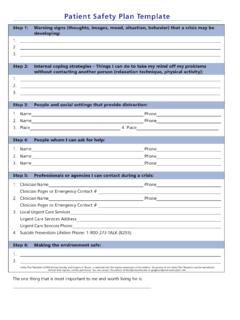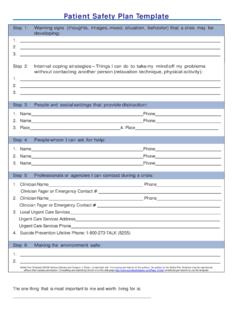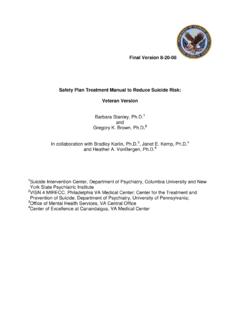Transcription of Documenting Individualized and Measurable …
1 Documenting Individualized and Measurable Patient Care Data HealthCare ConsultLink Diane Thomas, RN, MA 888-258-1894 Federal Conditions of Participation (c) ..provided by a qualified social worker, under the direction of a based on the patient s psychosocial assessment and the patient/family s needs and acceptance of these services. (b) ..must complete the comprehensive assessment within five calendar days after the election of hospice (c) Content of the comprehensive identify the physical, psychosocial, emotional, and spiritual needs related to the terminal order to promote the patient s well being, comfort, and dignity throughout the dying process COPs (c) Content of comprehensive assessment: (1) Nature and condition causing admission (2) Complications and risk factors that effect care planning (3) Functional status, including patient s ability to understand and participate in his/her own care (4) Imminence of death (5) Severity of symptoms COPs (c)(7) Bereavement initial bereavement on the social, spiritual, and cultural factors that may impact ability to (c)(8) Referrals and further evaluation by appropriate health professionals (d) Update of the comprehensive assessment.
2 By the IDT and must consider changes that have taken place since the initial information on progress toward desired outcomes and reassessment of response to less than every 15 days. COPs (e) Patient outcome measures (1) assessment must include data elements for measurement of in the same way for all patients (2) data elements must be part of the comprehensive be in Individualized patient care planning and coordination of be used as part of the aggregate for hospice s QAPI program COPs IDT, care planning, and coordination of services (a) hospice must designate an , registered nurse, social worker, pastoral or other counselor (b) ..all care and services must follow an Individualized written plan of patient and care giver must receive education and training appropriate to their responsibilities for the care and services identified in the plan of care COPs (c) must develop an Individualized written plan of care for each reflect patient/family goals and interventions based on assessments: (2) detailed statement of the scope and frequency of services (3) Measurable outcomes anticipated from implementing the plan of care (d) Review of plan of care.
3 Must review, revise, and less than every fifteen calendar include information from the updated comprehensive assessment and note patient s progress toward outcomes and goals specified in the plan of care. COPs (b)(3) Social worker personnel qualifications (i)(A) has an MSW from an accredited school of SW, or (B) has a baccalaureate degree in SW from an accredited school; or a baccalaureate degree in psychology, sociology, or other field in sociology and is supervised by an MSW; and (ii) has 1 year of social work experience in a healthcare setting; or (iii) has a baccalaureate , is employed by the hospice before Dec 2, 2008, and is not required to be supervised by an MSW. COPs (d)(2) Discharge from hospice; discharge planning process must include planning for any necessary family counseling.
4 Patient education, or other services before the patient is Interpreting the Regulations Your IDT must include a qualified SW. Without your presence, there is NO IDT meeting. Comprehensive assessment must be completed within 5 days of admission. Must include all elements identified in the COPs. If you identify a need for referral, you must follow up and document. Update to the comprehensive assessment must be done every 15 days by visit or phone call. Outcomes and interventions must be documented in Measurable outcomes. Must document progress toward goals. Plan of care must be cookie cutter documentation. Check boxes are only the beginning. Frequencies in the POC must be according to Patient/family need. Visits must match the frequency documented in the POC.
5 Updates to the plan of care must be made every fifteen days. SW must document discharge planning at least 5 days before discharge. Top Five Deficiencies Frequency written in the plan of care does not match the number of visits made Plan of care is not Individualized No Individualized problems No Measurable interventions and goals/outcomes No documentation of progress toward goals Care is not delivered according to the plan of care Did you do what you said you would do? Updates are not made to the plan of care at least every fifteen days (Must update the comprehensive assessment q 15d by phone call or visit.) Initial visit is not made within 5 calendar days of admission Functioning and the ICF ICF = International Classification of Functioning an outline (classification) of the whole person in her/his own environment Adopted by WHO in 2001 Assists in Documenting a picture of the patient in their world Goes beyond diagnosis and physical symptoms Categorizes whole person, including domains of: Activities Participation Environmental factors Personal factors ICF Domains are further subdivided: Body functions Structure functions Activity and Participation Environmental factors ICF Activity and Participation is classified.
6 Learning and applying knowledge General tasks and demands Communication Mobility Self-care Domestic life Interpersonal interactions and relationships Community life, social and civic life ICF Environmental factors: Products and technology Natural environment and human-made changes to environment Support and relationships Attitudes Services, systems, and policies ICF The ICF classification system provides a template for use in your initial and subsequent assessments. Whether you use the ICF or not, assessment and documentation must go beyond the diagnosis, must paint the picture, and must demonstrate that the Plan of Care is reasonable and necessary. The ICF can give you a structure from which to create your plan of care and build your documentation.
7 Dr. Ira Byock End-of-life developmental tasks: Task #1 Please forgive me. Task #2 I forgive you. Task #3 Thank you. Task #4 I love you. Task #5 Goodbye. From: Dying Well (1998) and The Four Things that Matter Most (2004) Stages of Psychosocial & Moral Development Erik Erikson s Stages of Psychosocial Development: Generativity vs. Stagnation How can I contribute to the world? Ego integrity vs. despair Did my life have meaning? Robert Peck: Task 2 - Body transcendence vs. body preoccupation Task 3 - Ego transcendence vs. ego preoccupation Daniel Levinson: mid-life crisis Final Season old vs.
8 Venerated elder Ravenna Helson: social clock Psychosocial/Moral Lawrence Kohlberg s Moral Development: Pre-conventional rewards and punishments Conventional pleasing others/ good members of society Post-conventional individual rights/ democratically accepted law; universal ethical principles Carol Gilligan s Moral Development (girls/women): Individual survival Goodness as self-sacrifice Morality of non-violence Documentation is an art, not a science. Write what you know, what you see, what you did, whether or not it worked, and what you will do next. Putting it all Assessment, Pain Safety Communication style and effectiveness Teaching Care giver support and resources Imminence of death Financial/legal assessment Psychosocial/emotional assessment, including suicide assessment Coping mechanisms Bereavement risk assessment Documentation Cycle Initial Assessment Documentation of assessment, goals, interventions Create Plan of Care based on Assessment Re-assess - what works, what doesn t Change Plan of Care, progress toward goals Questions to Think What are your future hopes (in next days/weeks/ months)?
9 What would you like to see happen? What is left undone? What are the things you worry about? What are some of your immediate problems? Your family s? If you could talk about anything, what would you talk about? Wish list/ bucket list How can we journey together? I don t know. If you did How is the Patient different today from your last visit? A week ago? Two months ago? Compare the Patient with a healthy person of this age. What are her/his limitations? Problem/ Intervention/ Goal Patient 87 y/o lifelong Roman Catholic female who is tearful during assessment. Through skillful interview and ref lective listening you learn that she is sad over an abortion she had at age 17. She has never shared this story with anyone. Problem: sadness over abortion at age 17 as evidenced by withdrawn behavior and tearful episodes.
10 Interventions: ref lective listening encouragement to tell personal story referral to chaplain for follow up Goals: decreased episodes of crying; increased peace verbalized feelings of acceptance/relief, etc. opportunity to ask forgiveness, say goodbye Problem/ Intervention/ Goal Patient is 93 y/o male NF resident with diagnosis Alzheimer s. He is non-responsive. There is no family of record to assist in developing the Plan of Care. Talk w/ facility staff to ascertain Patient history. (This in itself could be a problem/intervention/goal.) Problem: due to disease process, Patient is unable to interact with his environment, assist in development of care Intervention: read, sing, tell stories; guided imagery; facilitate relaxation response.








